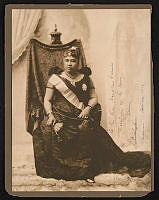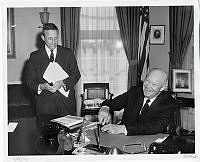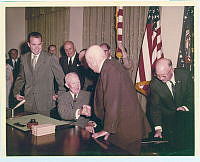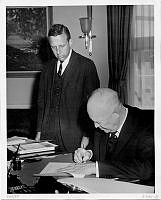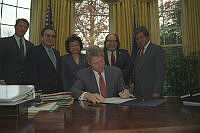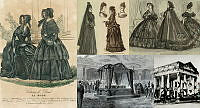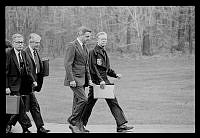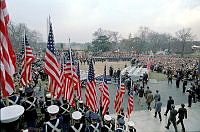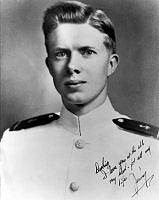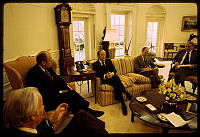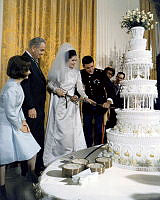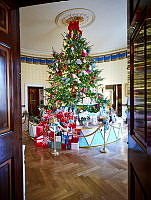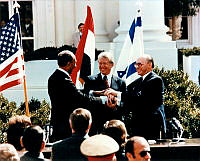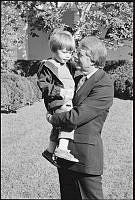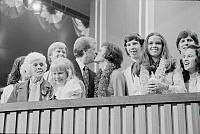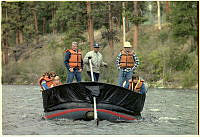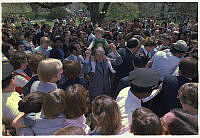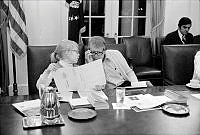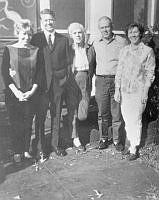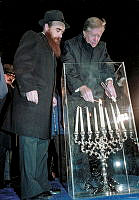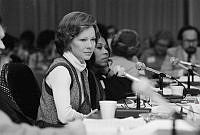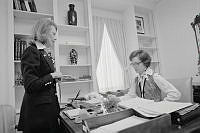Thomas Jefferson

Thomas Jefferson was born on April 13, 1743 in Albemarle County, Virginia to Jane and Peter Jefferson. His father was a Virginia planter, surveyor, and slave owner. At age fourteen, Jefferson’s father died, and Thomas inherited some thirty enslaved individuals. Jefferson fully embraced the lifestyle of an affluent member of the planter class, and over the course of his lifetime he owned over 600 enslaved people—the most of any American president.
In addition to building and managing his Monticello plantation, Jefferson pursued careers in law and public service. After receiving an education at the College of William & Mary, Jefferson studied law in Williamsburg. By 1769, he was serving in the Virginia House of Burgesses and three years later married Martha Wayles Skelton. They would have six children together, though only two survived to adulthood.
As tensions grew between the American colonies and Great Britain, Jefferson was elected to the Continental Congress. In 1776, he completed one of his greatest career achievements—The Declaration of Independence. As the primary author of this founding document, Jefferson drew upon Enlightenment ideals and the writings of John Locke, Montesquieu, and George Mason to formulate its most famous line: “We hold these truths to be self-evident, that all men are created equal, that they are endowed by their Creator with certain unalienable Rights, that among these are Life, Liberty, and the pursuit of Happiness.”
After the outbreak of the American Revolution, Jefferson was elected to the Virginia House of Delegates, where he worked tirelessly to revise state laws and draft Virginia’s state constitution. In 1786, he proudly authored a bill establishing religious freedom. Jefferson was also elected twice as Governor of Virginia for two one-year terms in 1779 and 1780.
Around the same time, Jefferson authored a treatise on the history, politics, geography, law, culture, and economics of Virginia. Published in 1785, Notes on the State of Virginia included Jefferson’s views on slavery. He argued for gradual emancipation of the state’s enslaved population, while also perpetuating racial prejudices about the inferiority of African Americans.
After his wife’s death in 1782, Jefferson joined Benjamin Franklin and John Adams as U.S. Minister to France. He brought along his daughters, Martha (known as Patsy) and Mary (known as Maria or Polly), and two enslaved individuals from Monticello—a brother and sister named James and Sally Hemings. Both Sally and James leveraged better positions for themselves in France, as that country had abolished slavery. Since they were technically free, Jefferson was willing to negotiate in order to bring them back to the United States. James eventually bargained for his freedom, while Sally, who entered into a sexual relationship with Jefferson, negotiated privileges for herself and her family before agreeing to return to Monticello. Jefferson fathered at least six of Sally’s children, four of whom survived to adulthood and were later freed by the former president. Click here to learn more about the enslaved households of President Thomas Jefferson.
In 1789, Jefferson returned from France and accepted an invitation to serve as Secretary of State for President George Washington. He quickly found himself at odds with Secretary of the Treasury Alexander Hamilton, clashing on issues such as the national debt, the location of a new and permanent capital city, and America’s diplomatic relationship with France. Eventually, Jefferson left Washington’s cabinet in 1793, but his rivalry with Hamilton reflected a broader political conflict, as two separate parties formed—the Federalists and the Democratic-Republicans. Jefferson soon emerged as a leader of the Democratic-Republicans, receiving enough Electoral College votes in 1796 to become vice president under John Adams. Four years later, Jefferson defeated Adams and Aaron Burr, assuming the presidency on March 4, 1801.
During Jefferson’s presidency, he focused on reducing the national debt by cutting military budgets and minimizing expenditures. He also fought to keep the United States out of the Napoleonic wars raging across Europe, opting to enact an unpopular embargo that closed American ports and crippled foreign trade—consequences that were felt by American merchants, businesses, and industries. As president, Jefferson also acquired 828,000 square miles of land west of the Mississippi River from France for $15 million. This land deal, known as the Louisiana Purchase, doubled the size of the United States, while setting up the fledgling nation for westward expansion throughout the nineteenth century.
Jefferson’s White House reflected his prior diplomatic experience. Preferring white laborers, he hired a French chef and butler, as well as several other white domestic workers. Jefferson also brought three enslaved teenagers from Monticello to train in the art of French cooking and hired out several enslaved individuals from local Washington slave owners.
After leaving the presidency in 1809, Jefferson retired to Monticello and spent his remaining years tending to the daily operation of his plantation, planning the University of Virginia, and hosting his friends and other esteemed guests. He died on July 4, 1826 at the age of eighty-three, fifty years to the day the Declaration of Independence was adopted.







